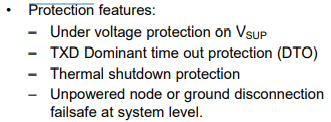Hi
The customer had a problem during the Short Circuit to Battery test.
The waveform is described below.
1. LIN Communication -> OK
2. Short Circuit to Battery @LIN Bus Line / over 10sec
a. LIN Rx & Tx Port output is lost.
b. LIN Transceiver, It is judged that it has entered sleep mode.
3. Wakeup Request
a. LIN Rx & Tx Initialization
4. LIN Communication -> OK
a. Output normal on LIN Rx & Tx Port. -> LIN Transceiver, Wake Up Mode
Questions.
1. Condition : Short Circuit to Battery @LIN Bus Line / over 10 sec
Is LIN Transceiver designed to enter slip mode or specific protection mode?
2. LIN communication is not working when LIN BUS Enable Pin (Blue) is high as shown in the waveform.
a. Did you enter Sleep Mode with Enable Pin low?
b. Is LIN communication stopped by certain protection?
Additional questions.
The protection features supported by TLIN1022-Q1 are specified in Datasheet as shown below.
Does TLIN1022-Q1 have other protection features & diagnostics?



